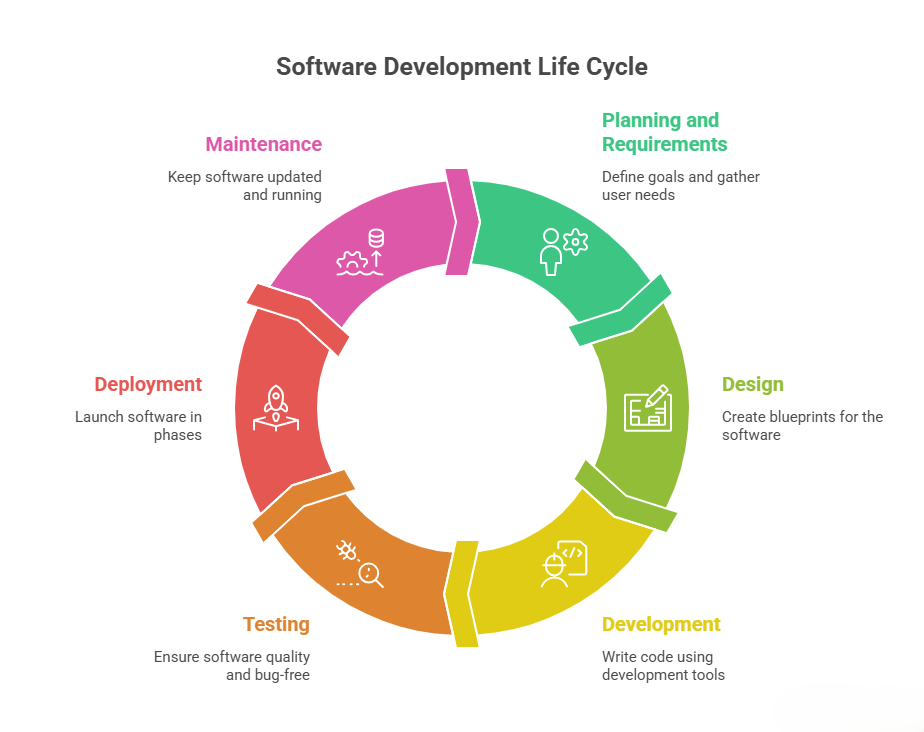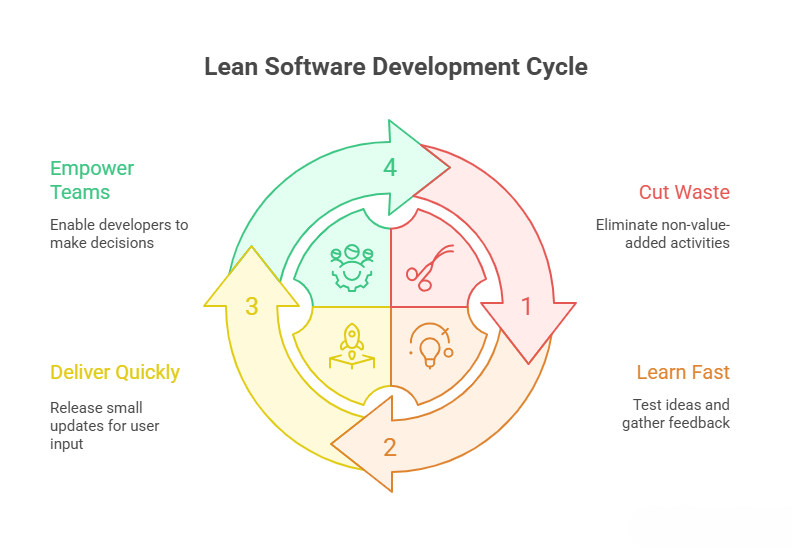Software Product Development Process: Tips for Leaders

Software Product Development Process: Best Practices for Success
As a CEO, I know how critical a solid software product development process is to a company’s success. In today’s fast-moving tech world, delivering high-quality software that customers love while staying ahead of competitors is tough.
For CEOs, CTOs, and decision-makers in the USA, getting the software development process right can drive innovation and growth.
This guide shares simple, proven software development best practices to help you lead your teams to success.
We’ll cover agile software development, software development tools, and more, with tips from my own experience.
Table of Contents
- Why the Software Product Development Process Matters
- Understanding the Software Development Lifecycle
- Using Agile Software Development
- Applying Lean Software Development
- Choosing the Right Software Development Tools
- Outsourcing vs. In-House Development
- Optimizing the Software Product Development Process
- Tackling Common Challenges
- The Role of Leadership in the Software Product Development Process
- Building a Strong Software Product Development Process
Why the Software Product Development Process Matters
The need for a reliable software product development process is higher than ever. Businesses rely on software to run operations, connect with customers, and boost profits. Whether you lead a software development company or manage a tech team, mastering the software development lifecycle ensures your projects succeed.
A weak process can lead to delays, budget overruns, and unhappy teams.
But with the right software development best practices, you can deliver products that shine.
Understanding the Software Development Lifecycle
The software development lifecycle (SDLC) is the foundation of a strong software product development process. It’s a step-by-step guide to planning, building, testing, and launching software. According to industry insights, a clear SDLC cuts risks and aligns projects with business goals.
Key Phases of the SDLC
- Planning and Requirements: Define goals, understand user needs, and set the project scope. Early stakeholder input prevents costly changes later.
- Design: Create blueprints for the software, including system architecture and user interfaces.
- Development: Write code using software development tools to speed up the process.
- Testing: Test thoroughly to ensure the software is bug-free and meets quality standards.
- Deployment: Launch the software, often in phases to reduce risks.
- Maintenance: Keep the software updated and running smoothly after launch.
Following a clear SDLC helps your software development company deliver products that meet user needs on time and within budget.

SDLC Phases and Key Activities
Using Agile Software Development
Agile software development is one of the best software development methodologies for delivering fast, flexible results. Unlike rigid traditional methods, agile focuses on teamwork, adaptability, and small, frequent updates.
As a CEO, I’ve seen agile software development transform custom software development projects, speeding up delivery and improving customer satisfaction.
Why Agile Works
Agile breaks projects into short cycles called sprints, usually lasting two to four weeks. Each sprint delivers a working piece of software, letting teams get feedback and adjust quickly.
According to MediaSearchGroup, agile boosts time-to-market and customer happiness.
Key Agile Practices
- Daily Standups: Quick meetings to align teams and solve issues.
- Sprint Planning: Set goals and tasks for each sprint.
- Retrospectives: Review what worked and what didn’t to improve next time.
- Continuous Integration: Merge code changes often to catch problems early.
Using agile software development keeps your team flexible and focused on delivering value.
Applying Lean Software Development
Lean software development is another great approach, focusing on delivering value while cutting waste. Inspired by lean manufacturing, it prioritizes what customers need and skips unnecessary steps.
Lean Principles for Software Development
- Cut Waste: Skip activities that don’t add value, like extra code or paperwork.
- Learn Fast: Test ideas and get feedback to improve quickly.
- Deliver Quickly: Release small updates to get user input sooner.
- Empower Teams: Let developers make decisions to spark innovation.
Lean principles help software development companies save resources and build products users love. As a CEO, I’ve found lean fosters efficiency and accountability.

Choosing the Right Software Development Tools
The right software development tools can supercharge your software product development process. From coding environments to version control, these tools make work faster and easier. Here are some top picks:
- IDEs: Visual Studio Code or IntelliJ IDEA offer great coding features like debugging and autocompletion.
- Version Control: Git, hosted on GitHub or GitLab, keeps code organized and collaborative.
- CI/CD Pipelines: Jenkins or CircleCI automate testing and deployment, reducing errors.
- Project Management: Jira or Trello help teams track tasks and deadlines.
Choosing the right tools boosts your software development services. Work with your CTO to pick tools that fit your team’s needs.
Outsourcing vs. In-House Development
Software development outsourcing can be a smart move for many companies. It gives access to global talent, cuts costs, and speeds up delivery. But it has challenges. I’ve led both in-house and outsourced projects, and both have their strengths.
Pros and Cons of Outsourcing
When exploring software development outsourcing, choose vendors with a strong track record. MediaSearchGroup notes outsourcing can cut costs by up to 40% while keeping quality high.
Tips for Successful Outsourcing
- Set Clear Goals: Share detailed requirements to avoid confusion.
- Pick the Right Partner: Choose vendors skilled in custom software development with a solid portfolio.
- Stay Involved: Regular check-ins and metrics keep projects on track.
- Use Agile: Agile methods give visibility and control over outsourced work.
Optimizing the Software Product Development Process
A smooth software product development process turns strategy into results. Fine-tuning your approach helps deliver high-quality software faster and more efficiently.
Practical, Actionable Steps
Prioritize User-Centric Design:
- Involve users early with prototypes and usability tests.
- Tools like Figma or Adobe XD help design intuitive interfaces.
- User feedback can significantly increase user engagement.
- Always put users first to ensure software meets real-world needs.
Automate Testing and Deployment:
- Automation saves time and reduces errors.
- Tools like Selenium or Cypress run automated tests to catch bugs early.
- CI/CD pipelines like Jenkins or GitHub Actions streamline deployment.
- Automating testing can cut bug-fixing time significantly.
- Automation frees developers to focus on coding new features, boosting creativity and productivity.
- Invest in tools that fit your team’s workflow to maximize efficiency.
Foster Collaboration:
- Break down barriers between developers, designers, and stakeholders.
- Use tools like Slack or Microsoft Teams for real-time communication.
- Regular check-ins and shared dashboards keep everyone aligned.
- Shared boards can reduce miscommunication and lead to earlier project delivery.
- Encourage open dialogue and ensure all voices are heard.
Monitor and Improve:
- Track software performance with analytics tools like Google Analytics or New Relic.
- Monitor user behavior, error rates, and system performance to identify areas for improvement.
- Post-launch data can help identify and fix user struggles, improving retention.
- Continuous monitoring ensures software stays competitive and relevant.
Invest in Continuous Learning:
- The tech world moves fast, so your team needs to keep learning.
- Encourage developers to stay updated on new methodologies and tools through workshops, online courses, or certifications.
- Platforms like Coursera or Pluralsight are great for upskilling.
- Investing in team training programs can boost productivity.
- A learning culture keeps your software product development process cutting-edge.
Balance Speed and Quality:
- Rushing to market can lead to sloppy code, but over-polishing delays delivery.
- Find a balance by setting clear priorities and using agile sprints to deliver incremental value.
- Launching a minimum viable product (MVP) with core features first can cut time-to-market while maintaining quality.
- Use data-driven decisions to balance speed and excellence.
Tackling Common Challenges
Managing Scope Creep:
- Scope creep happens when new features or requirements sneak into a project, causing delays and budget overruns.
- Combat it with clear project goals and agile sprints.
- Document requirements upfront and get stakeholder sign-off.
- Using a prioritized backlog and sticking to sprint goals can keep projects on schedule.
- Regular reviews with stakeholders ensure everyone agrees on the scope.
Reducing Technical Debt:
- Technical debt, quick fixes or shortcuts in code, can slow future development.
- Prioritize clean code and schedule regular refactoring sessions.
- Tools like SonarQube can spot code quality issues early.
- Dedicating a percentage of each sprint to refactoring can improve performance.
- A proactive approach keeps technical debt in check and supports long-term success.
Preventing Team Burnout:
- Overworked teams lead to burnout, which hurts morale and productivity.
- Balance workloads by setting realistic deadlines and encouraging time off.
- Foster a positive culture with recognition and team-building activities.
- Flexible hours and team outings can reduce turnover.
- Use tools like Jira to monitor workloads and ensure no one’s overwhelmed.
- A happy team drives a better software product development process.
Handling Miscommunication:
- Miscommunication between teams or with stakeholders can derail projects.
- Use clear documentation and regular check-ins to keep everyone aligned.
- Implementing weekly sync meetings and shared documentation can cut misunderstandings.
- Tools like Slack or Asana help streamline communication.
Adapting to Changing Requirements:
- Market needs or customer feedback can shift during development.
- Agile methodologies make it easier to adapt.
- Break projects into smaller sprints and prioritize flexibility.
- Agile helps pivot quickly to deliver revised products on time.
- Stay open to feedback and use it to refine your software product development process.
The Role of Leadership in the Software Product Development Process
As a CEO or CTO, your job is to set the vision and support your teams. Invest in training, encourage innovation, and align projects with business goals. Explore new software development methodologies to stay ahead.
For example, I once switched a project to lean software development mid-way. It cut delivery time by 30% and boosted customer satisfaction.
Leadership means making bold calls and trusting your team to deliver.
Building a Strong Software Product Development Process
A great software product development process blends strategy, execution, and flexibility. By mastering the software development lifecycle, using agile and lean approaches, and choosing the right software development tools, you can set your company up for success. Whether you build in-house or use software development outsourcing, focus on users and data-driven decisions.
As a leader in the USA, you can drive innovation by refining your software product development process. Start by reviewing your current approach and adopting one new best practice. For more tips, check out MediaSearchGroup’s guide or explore trends on AdTargeting.
Look at your software development process today. Are you using the best tools and methods?
Talk to your CTO and team to improve one area this quarter, and watch your projects succeed.


